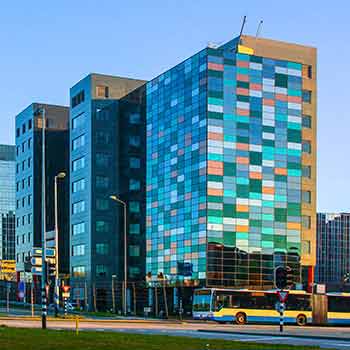Networks and Graphs - Period 2
Business & Economics Program
Amsterdam, Netherlands
Dates: 8/19/23 - 12/23/23

Networks and Graphs - Period 2
OVERVIEW
CEA CAPA Partner Institution: Vrije Universiteit Amsterdam
Location: Amsterdam, Netherlands
Primary Subject Area: Computer Sciences
Instruction in: English
Course Code: X_401010
Transcript Source: Partner Institution
Course Details: Level 200
Recommended Semester Credits: 3
Contact Hours: 84
DESCRIPTION
The world around us is becoming increasingly connected. This increased connectivity is leading to new phenomena that are not that easy to understand:
- why is it difficult, if not impossible, to remove data from the Web?
- why does the Internet continue to function despite big disasters?
- why is Google so effective and efficient?
- why are navigation systems so responsive to traffic jams?
- why do certain diseases spread so rapidly and others not?
The core of the answers to these questions is formed by the notion of "network:" a mathematical concept consisting of nodes that are joined by edges. Networks are also called graphs. In the last 15 years we have seen an increase in interests for networks/graphs. Many real-world phenomena turned out to be conveniently modeled by networks, and in such a way that it allowed us to better understand those phenomena.
In this course, graph theory and its applications are the main focus point. We'll be paying attention to the math that underlies graphs and networks, as well as the application to real-world situations. In particular, you will be conducting simple experiments dealing with the construction and analyses of networks. Application domains that are discussed are selected from:
- the Internet
- the Web
- peer-to-peer computer systems
- biological networks
- social communities and online social networks
We'll putting emphasis on:
1. Standard mathematical terminology and techniques, including:
- directed and undirected graphs
- planar graphs
- graph embeddings
- edge and vertex coloring
- optimal routing
- trees
2. Experimental analyses of networks.
To this end, we'll be discussing various ways to measure network properties, like the relative position of (important) nodes, clustering coefficients, diameter, eccentricities, and so on.
Vrije Universiteit Amsterdam (VU Amsterdam) awards credits based on the ECTS system. Contact hours listed under a course description may vary due to the combination of lecture-based and independent work required for each course therefore, CEA?s recommended credits are based on the ECTS credits assigned by VU Amsterdam. 1 ECTS equals 28 contact hours assigned by VU Amsterdam.
- why is it difficult, if not impossible, to remove data from the Web?
- why does the Internet continue to function despite big disasters?
- why is Google so effective and efficient?
- why are navigation systems so responsive to traffic jams?
- why do certain diseases spread so rapidly and others not?
The core of the answers to these questions is formed by the notion of "network:" a mathematical concept consisting of nodes that are joined by edges. Networks are also called graphs. In the last 15 years we have seen an increase in interests for networks/graphs. Many real-world phenomena turned out to be conveniently modeled by networks, and in such a way that it allowed us to better understand those phenomena.
In this course, graph theory and its applications are the main focus point. We'll be paying attention to the math that underlies graphs and networks, as well as the application to real-world situations. In particular, you will be conducting simple experiments dealing with the construction and analyses of networks. Application domains that are discussed are selected from:
- the Internet
- the Web
- peer-to-peer computer systems
- biological networks
- social communities and online social networks
We'll putting emphasis on:
1. Standard mathematical terminology and techniques, including:
- directed and undirected graphs
- planar graphs
- graph embeddings
- edge and vertex coloring
- optimal routing
- trees
2. Experimental analyses of networks.
To this end, we'll be discussing various ways to measure network properties, like the relative position of (important) nodes, clustering coefficients, diameter, eccentricities, and so on.
Vrije Universiteit Amsterdam (VU Amsterdam) awards credits based on the ECTS system. Contact hours listed under a course description may vary due to the combination of lecture-based and independent work required for each course therefore, CEA?s recommended credits are based on the ECTS credits assigned by VU Amsterdam. 1 ECTS equals 28 contact hours assigned by VU Amsterdam.







